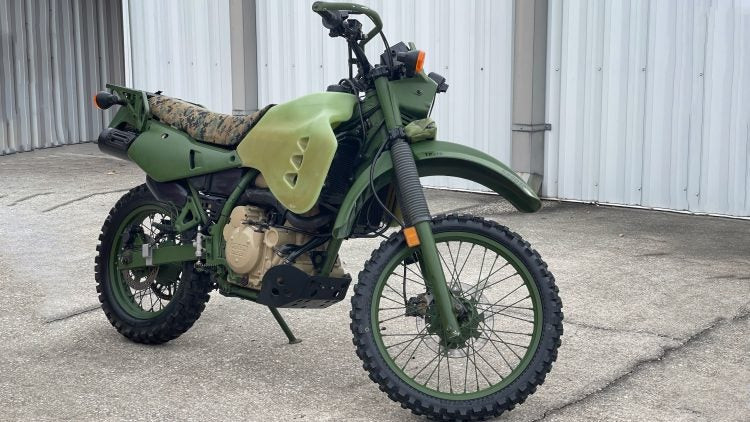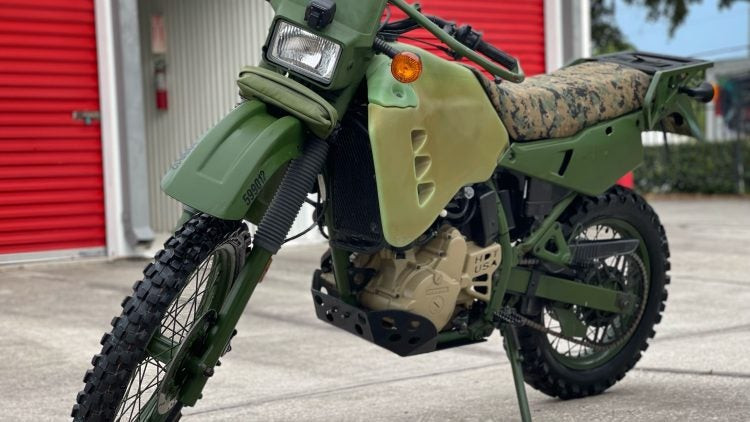Motorcycles have long been essential tools in military operations, prized for their versatility across diverse terrains. However, the reliance on gasoline engines can create logistical challenges for armed forces primarily using diesel, kerosene, or jet fuel. This is where the story of the “Diesel KLR” begins, a remarkable machine developed roughly two decades ago by an American company to address this very issue for the U.S. military. This bike has since become a legend, showcasing the practicality and potential of Diesel Dirt Bikes.
 Hayes Diversified Technologies Diesel KLR Engine Conversion for Military Use
Hayes Diversified Technologies Diesel KLR Engine Conversion for Military Use
Tracing the Roots: The KLR’s Military Pedigree
The Diesel KLR project emerged during the peak popularity of the Kawasaki KLR650, a motorcycle celebrated for its practicality and affordability as an all-rounder. Kawasaki’s history of supplying bikes to NATO militaries further paved the way for this innovative endeavor. For over a decade, the KLR250 had already established a solid reputation within military and paramilitary units in Canada, the U.S., and other nations. Building on this foundation, the U.S. military turned to Kawasaki for their new initiative, but with a groundbreaking alteration: entrusting Hayes Diversified Technologies to convert the engines to run on diesel fuel.
The design and development phase was extensive and garnered significant public attention at the time. Hayes Diversified Technologies undertook the complex task of modifying the KLR650 engine. While retaining the standard KLR650 bottom end, including the cases and five-speed gearbox, they innovatively replaced the top end with a liquid-cooled single-cylinder configuration. This new top end was engineered to operate on diesel, biodiesel, kerosene, or jet fuel, aligning with NATO’s fuel standardization requirements. This crucial adaptation meant that in operational scenarios, support personnel could refuel these diesel dirt bikes directly from the same fuel supplies used for other military vehicles, simplifying logistics and enhancing operational efficiency. Initial production runs were reportedly intended for the Marine Corps, with some sources suggesting potential builds for European militaries as well.
 Hayes Diversified Technologies Custom Components on Military Diesel Motorcycle
Hayes Diversified Technologies Custom Components on Military Diesel Motorcycle
Mission Success: Performance and Practicality of the Diesel KLR
After considerable development and refinement, the diesel-powered KLR successfully entered production, with an estimated 200 units manufactured. This timing coincided with the burgeoning War on Terror, providing ample opportunities for the American military to deploy and evaluate these machines in real-world conditions.
Initial reactions from moto-journalists who test-rode the diesel bikes revealed a nuanced picture. These weren’t high-performance powerhouses. The diesel-converted KLRs produced around 30 horsepower, even less than the gasoline-powered KLR650. However, the narrative quickly shifted to the remarkable fuel economy and exceptional torque of these diesel dirt bikes. Reviews consistently lauded their impressive pulling power, a characteristic highly valued in demanding terrains and operational scenarios.
 Military Diesel Motorcycle KLR Details
Military Diesel Motorcycle KLR Details
Beyond military applications, Hayes’ diesel dirt bikes also demonstrated their capabilities in unexpected arenas. They participated in Bonneville Salt Flats races, where their unique diesel powerplant likely secured them a distinguished position in the single-cylinder diesel category. Furthermore, the diesel KLR became a regular participant in Craig Vetter’s fuel economy challenges for years, competing in both streamlined and non-streamlined classes. The streamlined version achieved astonishing fuel efficiency. Fred Hayes himself achieved multiple victories in these events, highlighting the real-world practicality of diesel power for motorcycles, particularly when prioritizing torque and fuel economy. Vetter consistently praised Hayes’ creations for their usability and significantly greater torque compared to gasoline counterparts in his post-challenge analyses.
 Hayes Diversified Technologies Diesel KLR Civilian Version Concept
Hayes Diversified Technologies Diesel KLR Civilian Version Concept
The Diesel KLR Today: A Collector’s Item
In recent years, a limited number of these Diesel KLRs have surfaced for sale online as military surplus vehicles are decommissioned. Whether they remain in active USMC service is uncertain. The specific bike featured in these images was offered by Mecum Auctions, described as “the last and known lowest mileage KLR decommissioned according to issuing SF-97 agency,” adding to its rarity and collector appeal.
Before the COVID-19 pandemic, these machines were available on the surplus market for around $5,000 USD. As these diesel dirt bikes become increasingly scarce, their value in the collector motorcycle market is expected to rise. However, beyond their investment potential, the true value of a Diesel KLR might lie in the experience of riding and appreciating this unique piece of military and motorcycle history for its innovative engineering and practical capabilities.
